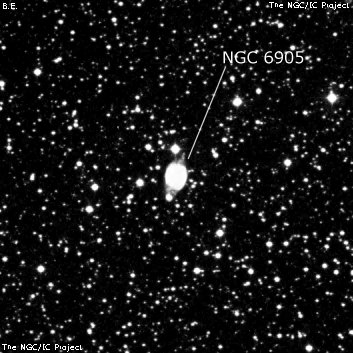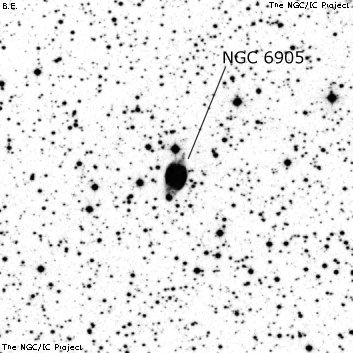NGC/IC Project Restoration Effort
(This is a very very beta version)
NGC6905


Basic Information
Location and Magnitude
Right Ascension: 20:22:23.0
Declination: +20:6:18
Constellation: DEL
Visual Magnitude: 11.1
Historic Information
Discoverer: Herschel W.
Year of discovery: 1784
Discovery aperture: 18.7
Observational
Summary description: !!, planetary, B, pS, R, 4 S st nr
Sub-type: PN
Steve's Notes
=====
NGC 6905
24" (8/14/15): the "Blue Flash" planetary was observed at 500x and 750x in excellent seeing. The main body is oval 5:4 NNW-SSE, ~48"x40" and annular. The rim is brightest along a thin strip on the east side and enhanced in a slightly brighter triangular wedge (roughly 60¡-80¡) extending east from the mag 15.7 central star. The opposite western rim is also brighter, but the north and south ends are not enhanced. The interior is mottled with a slightly darker, irregular central "hole", particularly on the south and west side of the central star, but not to the east. Mag 10.4 HD 352100 lies 48" N of center and a mag 12 star is 38" SSE of center, in the direction of the major axis.
An extremely faint outer halo or wing was occasionally glimpsed off the north-northwest end, tapering in the direction of the major axis and extending 10"-12" in length. The corresponding extension off the south-southeast side and ending at the mag 12 star (completing a lens-shaped outline out of a truncated ellipse on deep images) was not seen, although Jimi Lowrey felt it was equally visible.
48" (5/16/12): beautiful blue oval planetary with a fairly bright central star. Very nice annular appearance with an irregular darker interior. A bright arc is along the east or northeast rim and a slightly weaker counterpart was on the west or southwest edge. The ends are somewhat chopped off, creating a rectangular appearance.
18" (7/2/08): at 565x, this interesting planetary had a very irregular surface brightness and appeared weaker on the north and south sides and slightly brighter in a triangular wedge that fanned out to the east from the central star. The edge of the western rim was also very slightly enhanced but there wasn't a complete brighter wedge on the west side of the central star, which would have created a subtle bipolar dumbbell shape. The faint central star was visible continuously at this magnification.
18" (8/23/03): beautiful planetary at 320x and 538x. The mag 15.7 central star is easily visible continuously. The interior seems unevenly lit and there appears to be a very slightly darker "hole" to the north of the central star. Bracketed by a mag 11 star off north edge and a mag 12 star just off the south edge and the planetary is slightly elongated N-S in the direction of these stars.
17.5" (8/31/86): very pretty planetary at 280x. Fairly bright, fairly small, slightly elongated. A very faint central star (V = 15.7) is visible. Takes 440x well. Just off the north edge is a mag 11 star 1.4' from center and a mag 12 star is just off the south edge 39" from center.
8" (6/29/84): moderately bright, uniform, slightly elongated N-S, two stars at the northeast and south edge.



